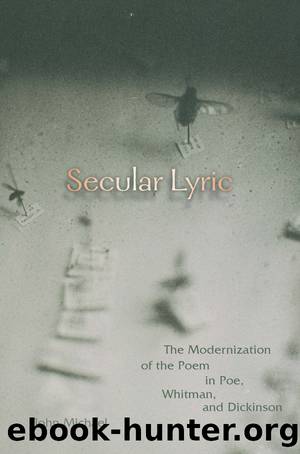Secular Lyric by Michael John;

Author:Michael, John;
Language: eng
Format: epub
Publisher: Fordham University Press
PART III
Emily Dickinson
CHAPTER 5
The Poet as Lyric Reader
If Whitman works to embrace and incorporate the crowd into the texture of his poetry and of the self who sings it, Dickinson seems to work equally hard to hold her audience, and sometimes even the world, at a distance. Sometimes she links her poetry to the epistolary impulse to address a single other as in âIf you were coming in the Fall, / Iâd brush the Summer by / With half a smile, and half a spurn, / As Housewifeâs do, a Flyâ (F356).1 Sometimes she seems to reject this world altogether to focus attention on the next as in âThis World is not conclusion. / A species stands beyondâ/ Invisible, as Musicâ/ But positive, as Soundââ (F373). And among the many poems she wrote about poetry and the poetâs office are a fair number that seem skeptical about the entire enterprise of writing verse as in âI would not painâa pictureââ which concludes âNor would I be a Poetâ/ Itâs finerâOwn the Earâ/ Enamoredâimpotentâcontentâ/ The License to revere, / A privilege so awful / What would the Dower be, / Had I the Art to stun myself / With Boltsâof Melody!â (F348). In part because of the amazing variety of poetic expressions contained in the now-printed corpus of her nearly eighteen hundred lyrics, Dickinson has become the touchstone for debates about the nature of lyric as a genre, its status in the nineteenth century, and the validity of modern practices of close reading when applied to texts like hers.2 Because I am interested in the modernity of Dickinsonâs poetry, some consideration of these debates will be necessary to move my readings forward.
In the broadest sense, I would say that Dickinsonâs poetry fits the broader definition of the lyric that Jonathan Culler has recently advanced. Unlike generations of critics, since the nineteenth century, who have associated lyric with the expression of the lyric âI,â Culler identifies it with epideictic rhetoric, the mode that seeks to describe the world, and sometimes to praise or blame what happens in it. Cullerâs argument reminds us that many poems we consider lyrics do not obviously foreground self-expression. Many of Dickinsonâs most familiar poems, because of the presence of a lyric or perceiving âIâ in them, seem lyrical in this sense. They make statements about the world that sometimes do and sometimes do not depend upon the speakerâs presence in the poem. Her observation of a hunting cat, for example, describes a moment in the worldâs existence but does not depend directly on the poetâs âIâ in the poem: âShe sights a Birdâshe chucklesâ/ She flattensâthen she crawlsâ/ She runs without the look of feetâ/ Her eyes increase to Ballsââ (F351).
It remains the case, however, that whether one seeks to define lyric or to define the genre away, Dickinson seems to come to mind. The debates around âthe new lyrical studies,â whose proponents often seek to make distinctions between modern close reading practices, modern poetry more generally and the nature of traditional lyric poetry are a case in point.
Download
This site does not store any files on its server. We only index and link to content provided by other sites. Please contact the content providers to delete copyright contents if any and email us, we'll remove relevant links or contents immediately.
The Power of Myth by Joseph Campbell & Bill Moyers(936)
Half Moon Bay by Jonathan Kellerman & Jesse Kellerman(920)
A Social History of the Media by Peter Burke & Peter Burke(886)
Inseparable by Emma Donoghue(854)
The Nets of Modernism: Henry James, Virginia Woolf, James Joyce, and Sigmund Freud by Maud Ellmann(772)
The Spike by Mark Humphries;(730)
A Theory of Narrative Drawing by Simon Grennan(712)
The Complete Correspondence 1928-1940 by Theodor W. Adorno & Walter Benjamin(711)
Ideology by Eagleton Terry;(665)
Bodies from the Library 3 by Tony Medawar(656)
World Philology by(649)
Culture by Terry Eagleton(648)
Farnsworth's Classical English Rhetoric by Ward Farnsworth(647)
Adam Smith by Jonathan Conlin(618)
A Reader’s Companion to J. D. Salinger’s The Catcher in the Rye by Peter Beidler(616)
Game of Thrones and Philosophy by William Irwin(604)
High Albania by M. Edith Durham(598)
Comic Genius: Portraits of Funny People by(588)
Monkey King by Wu Cheng'en(583)
